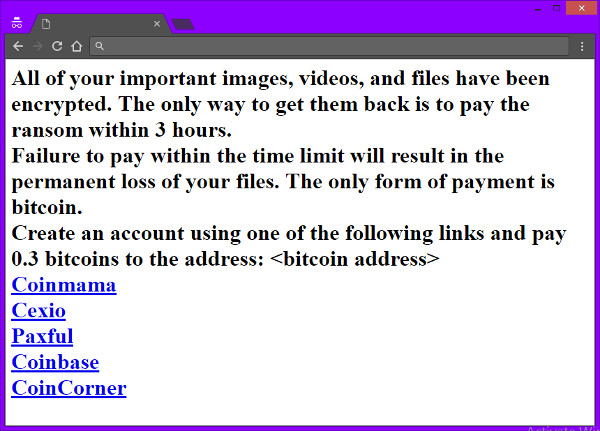RANSOM_TRESORAS.A
Trojan-Ransom.Win32.Cryptor.hp (Kaspersky); Python/Filecoder.S trojan (NOD32)
Windows


Threat Type: Ransomware
Destructiveness: No
Encrypted: No
In the wild: Yes
OVERVIEW
Dropped by other malware, Downloaded from the Internet
This Ransomware arrives on a system as a file dropped by other malware or as a file downloaded unknowingly by users when visiting malicious sites.
TECHNICAL DETAILS
4,476,159 bytes
, EXE
No
05 Apr 2017
Drops files
Arrival Details
This Ransomware arrives on a system as a file dropped by other malware or as a file downloaded unknowingly by users when visiting malicious sites.
Autostart Technique
This Ransomware drops the following file(s) in the Windows User Startup folder to enable its automatic execution at every system startup:
- {malware filename}.exe
Dropping Routine
This Ransomware drops the following files:
- {malware path}\NOTE.html - ransom note
Other Details
This Ransomware does the following:
- It deletes shadow copies:
vssadmin.exe delete shadows /all /quiet - It disables Windows automatic repair and error recovery:
bcdedit.exe /set {default} recoveryenabled no
bcdedit.exe /set {default} bootstatuspolicy ignoreallfailures
NOTES:
NOTE.html contains the following message:

SOLUTION
9.850
13.336.02
12 Apr 2017
13.337.00
13 Apr 2017
Step 1
Before doing any scans, Windows XP, Windows Vista, and Windows 7 users must disable System Restore to allow full scanning of their computers.
Step 2
Note that not all files, folders, and registry keys and entries are installed on your computer during this malware's/spyware's/grayware's execution. This may be due to incomplete installation or other operating system conditions. If you do not find the same files/folders/registry information, please proceed to the next step.
Step 3
Search and delete this file
- {malware path}\NOTE.html
Step 4
Scan your computer with your Trend Micro product to delete files detected as RANSOM_TRESORAS.A. If the detected files have already been cleaned, deleted, or quarantined by your Trend Micro product, no further step is required. You may opt to simply delete the quarantined files. Please check this Knowledge Base page for more information.
Step 5
Restore encrypted files from backup.
Did this description help? Tell us how we did.

